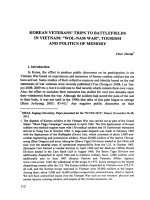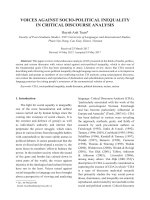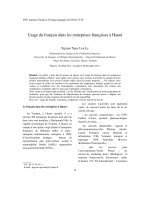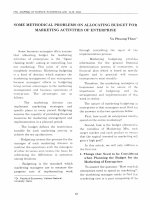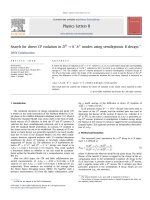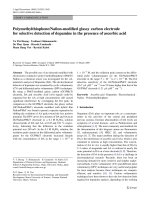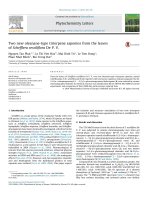DSpace at VNU: Patient Satisfaction withMethadone Maintenance Treatment in Vietnam: A Comparison of Different Integrative-Service Delivery Models 5.Nguyen Hoang Long
Bạn đang xem bản rút gọn của tài liệu. Xem và tải ngay bản đầy đủ của tài liệu tại đây (458.38 KB, 12 trang )
RESEARCH ARTICLE
Patient Satisfaction with Methadone
Maintenance Treatment in Vietnam: A
Comparison of Different Integrative-Service
Delivery Models
Bach Xuan Tran1,2*, Long Hoang Nguyen1,3, Huong Thu Thi Phan4, Carl A. Latkin2
a11111
1 Institute for Preventive Medicine and Public Health, Hanoi Medical University, Hanoi, Vietnam, 2 Johns
Hopkins Bloomberg School of Public Health, Baltimore, Maryland, United States of America, 3 School of
Medicine and Pharmacy, Vietnam National University, Hanoi, Vietnam, 4 Authority of HIV/AIDS Control,
Ministry of Health, Hanoi, Vietnam
*
OPEN ACCESS
Citation: Tran BX, Nguyen LH, Phan HTT, Latkin CA
(2015) Patient Satisfaction with Methadone
Maintenance Treatment in Vietnam: A Comparison of
Different Integrative-Service Delivery Models. PLoS
ONE 10(11): e0142644. doi:10.1371/journal.
pone.0142644
Editor: Gabriele Fischer, Medical University of
Vienna, AUSTRIA
Abstract
Background
Patient satisfaction is an important component of quality in healthcare delivery. To inform
the expansion of Methadone Maintenance Treatment (MMT) services in Vietnam, we examined the satisfaction of patients with regards to different services delivery models and identified its associated factors.
Received: August 7, 2015
Methods
Accepted: October 23, 2015
We interviewed 1,016 MMT patients at 5 clinics in Hanoi and Nam Dinh province. The modified SATIS instrument, a 10-item scale, was used to measure three dimensions: “Services
quality and convenience”, “Health workers’ capacity and responsiveness” and “Inter-professional care”.
Published: November 10, 2015
Copyright: © 2015 Tran et al. This is an open
access article distributed under the terms of the
Creative Commons Attribution License, which permits
unrestricted use, distribution, and reproduction in any
medium, provided the original author and source are
credited.
Data Availability Statement: Due to legal
restrictions imposed by the government of Vietnam
regarding patient confidentiality, data are available
upon request. Requests for data may be sent to Dr.
Phan Thi Thu Huong ().
Funding: This study was funded by the Vietnam
Authority of HIV/AIDS Control World Bank supported
HIV Project. Dr. Bach Tran received a fellowship from
the International AIDS Society and US National
Institute of Drug Abuse. The funders had no role in
study design, data collection and analysis, decision to
publish, or preparation of the manuscript.
Results
The average score was high across three SATIS dimensions. However, only one third of
patients completely satisfied with general health services and treatment outcomes. Older
age, higher education, having any problem in self-care and anxiety/depression were negatively associated with patient’s satisfaction. Meanwhile, patients receiving MMT at clinics,
where more comprehensive HIV and general health care services were available, were
more likely to report a complete satisfaction.
Conclusion
Patients were highly satisfied with MMT services in Vietnam. However, treatment for drug
users should go beyond methadone maintenance to address complicated health demands
of drug users. Integrating MMT with comprehensive HIV and general health services
PLOS ONE | DOI:10.1371/journal.pone.0142644 November 10, 2015
1 / 12
Satisfaction with Methadone Maintenance Treatment
Competing Interests: The authors have declared
that no competing interests exist.
together with improving the capacity of health workers and efficiency of services organisation to provide interconnected health care for drug users are critical for improving the outcomes of the MMT program.
Introduction
In Vietnam, HIV concentrated epidemic is mostly attributable to people who inject drug
(PWID). It is estimated that there were 180,000 drug users and over 70% of them had a history
of intravenous use[1–4]. A recent study shows that the prevalences of HIV and HCV among
drug users were 35.1 and 88.8%, respectively[5]. Heroin is the most widely consumed (90%)
drug in the country[4, 6, 7]. Methadone maintenance treatment (MMT) is considered a standard medication for drug abuse treatment[8]. Since its first introduction in 2008, to date,
approximately 31.200 illicit drug users (DUs) has received MMT in 170 nationwide clinics [4,
6, 7, 9, 10]. With the strong political will, Vietnam government has a plan to scale-up the coverage of MMT program to 80.000 DUs in the following years[10]. However, this plan has to face
a challenge from a rapid cut of financial aids from international donors[10]. To address this
issue, strategies to reduce operational resources and optimize the efficiency are necessary to
ensure the sustainability of MMT program. This requirement raises the need to understand the
performance and quality of diverse MMT services in Vietnam.
Model to deliver MMT services may vary across settings such as stand-alone or integrating
with other health care services[1]. The later model includes integrations of MMT with Provincial AIDS centers, Regional Polyclinic, and District Health Centers[1, 3]. To assess the performance of health services, self-reported information about patient experience and satisfaction
play an indispensable role along with traditional health outcomes [11]. In particular, the
patient satisfaction helps program managers to recognize the responsiveness of service delivery
by measuring whether the patients’ needs are tackled, identifying the gaps and reflecting the
quality of environment or health staffs in clinics [12, 13]. Besides, in opioid dependence treatment, patient satisfaction may use to predict the retention, adherence, treatment outcome and
risk of drug relapse [13–15]. Levels of satisfaction as well as their determinants varied across
socio-economic factors, health status, characteristics of MMT clinics as well as dose of MMT
[16–18]. Accordingly, MMT providers should learn to understand the characteristics of patient
satisfaction in each setting, which is important to improve service delivery.
Currently, Vietnam has implemented MMT clinics in various models, including not only
standalone- but also integrative- services. For example, MMT service may be co-located or
combined with other HIV-related services such as antiretroviral treatment (ART) or HIV
counselling and testing services (VCT). Likewise, it can be integrated with general health care
service. However, in Vietnam, none of literature has mentioned the satisfaction of MMT
patients for their attended clinics. Thus, the purpose of this paper was to examine the difference
of satisfaction among MMT patients in various service delivery models and explore related
factors.
Methods
Ethics approval
The protocol of this study was reviewed and approved by the Vietnam Authority of HIV/AIDS
Control's Scientific Research Committee. Written informed consent was obtained from all
PLOS ONE | DOI:10.1371/journal.pone.0142644 November 10, 2015
2 / 12
Satisfaction with Methadone Maintenance Treatment
participants. Patients could withdraw at any time without the influence on their current
treatment.
Study design and sampling technique
From January to August 2013, a cross-sectional survey was conducted in two Vietnamese HIV
epicenters namely Hanoi and Nam Dinh. Five clinics were purposively selected in the study
based on following criteria: 1) delivering MMT services; 2) representing both urban and rural
areas, and 3) covering various levels of health system such as provincial- and district- levels.
The detailed information of clinics is described in Table 1. It is important to notice that this
study sample has a limited representativeness for the MMT patient population. We selected
the two provinces in consultation with program managers at the Vietnam Authority of HIV/
AIDS for a purposive comparison of an experienced setting—Hanoi and a new setting—Nam
Dinh Province. Also the selection of MMT sites was primarily for the comparison of various
service develivery models in different level of health administration.
We invited all patients who were present at seclected MMT clinics to participate in the
study. The eligibility criteria: 1) presenting at clinics during study period; 2) being 18 years old
or above; 3) having capacity to answer the questionnaire and 4) providing informed consent to
participate.
Initially, patients were invited to a designated counseling room to ensure their privacy.
Then, interviewer introduced the purposes of this study and the benefits to improving MMT
program that in turn support the patients as they accepted to participate. Finally, we gave written informed consents to patients for signature. Data collection procedure was conducted
within 15 to 30 minutes by well-trained researchers. There was none of MMT health staffs
involving in this procedure. A total of 1,016 patients were recruited in the study.
Measures and instruments
A structured questionnaire was developed for data collection. The information of concern
included socio-economic factors (age, gender, education, marital, religion and employment status), health status (including HIV status) and type of MMT models. Those variables were
selected based on previous studies [16–18].
EQ-5D-5L instrument was used to measure health status. Its Vietnamese version was validated elsewhere [19]. This instrument includes five dimensions (mobility, self-care, usual activities, pain/discomfort, and anxiety/depression) with five response levels, from “No problem” to
“Extremely problem” [19, 20]. We categorized people who reported “Slightly” to “Extremely”
into “Having problem” group, while others classified “No problem”.
To measure the patient satisfaction, we modified a previously developed instrument for
Vietnamese settings, namely Satisfaction with HIV/AIDS Treatment Interview Scale
(SATIS). This generic instrument was used to measure the satisfaction of patients for HIV/
AIDS-related services. The procedure to develop this scale was described elsewhere [21]. Generally, SATIS includes 10 items with the range of options for response being from 0 to 10,
where 0 indicated complete dissatisfaction and 10 indicated complete satisfaction. The scores
of specific domains were computed by averaging the score of correspond items. The higher
score means the higher level of satisfaction. Additionally, the instrument comprises two global
ratings of overall satisfaction with health services and treatment outcomes. This instrument
was used to measure the patient satisfaction for HIV-related service delivery models in Vietnam [21]. In this study, SATIS was speficified for MMT clinics and other quality features was
asked for the MMT that patients were attending while the measure items’ content, response
options and scoring remained unchanged.
PLOS ONE | DOI:10.1371/journal.pone.0142644 November 10, 2015
3 / 12
Satisfaction with Methadone Maintenance Treatment
Table 1. Study settings and sample size.
Level
Settings
Site Name
Type of services
Sample size
Province
Nam Dinh City
Provincial AIDS Centre
MMT+ VCT
270
District (rural)
Xuan Truong District
District Health Centre
MMT+ VCT + ART + GH
151
District (urban)
Tu Liem District
District Health Centre
MMT+ VCT + ART + GH
201
District (urban)
Long Bien District
District Health Centre
MMT+ VCT + ART + GH
184
District (urban)
Ha Dong District
Regional Polyclinic
MMT+ GH
210
VCT: Voluntary HIV Counseling and Testing; ART: Antiretroviral Treatment; GH: General Health; MMT: Methadone Maintenance Treatment.
doi:10.1371/journal.pone.0142644.t001
Statistical analysis
In this study, we employed exploratory factor analysis (EFA) to explore the construct validity
of the SATIS measurement. Principle component analysis was used to extract those factors. An
eigenvalue of 0.35, where its curve flattened out, was selected as a threshold. The threshold was
defined by the scree test. We used Orthogonal Varimax rotation with Kaisers’ normalization to
re-organize items in the scale, which aimed to increase the interpretability of these factors. A
value of 0.55 was utilized to be a cut-off point for factor loadings. We also performed a crossloading in one item and then assigned it to the appropriate domain based on both the nature of
the question and the overarching dimension.
Cronbach’s alpha was used to assess the internal consistency reliability of measurement.
Chi-squared, t-test and ANOVA were used to explore the differences of satisfaction among
characteristics. Multivariate linear and logistic regressions were employed to identify the associated factors with reclassified domains and general satisfaction. In this study, we applied a
stepwise forward model strategy which using log-likelihood ratio test at a p-value of 0.1 to
select variables for the reduced models [22]. A p-value < 0.05 was set as the level of statistical
significance.
Results
Table 2 shows the socio-economic status and health status of the sample. Overall, the mean age
of respondents was 35.8 (SD = 7.5). The majority of patients were male (98.7%), attaining secondary school or above (86.6%) and living with spouse (67.4%). Most of the patients were cult
of ancestors (88.2%) and self-employed (53.4%). Regarding to health status, the proportion of
respondents having HIV-positive status was 8.1%. When only 7.3%, 3.9% and 5.9% had problems in morbidity, self-care and usual activity, respectively, about one of five respondents had
pain/discomfort and anxiety/depression problems (17.7% and 20.7%, correspondingly).
The construct validity of SATIS was displayed in Table 3. Three dimensions were reclassified from factor analysis namely “Services quality and convenience”, “Health workers’ capacity
and responsiveness” and “Inter-professional care”. Those dimensions accounted for 84.3% of
the variance, of which the highest share of the variance belonged to the first dimension with
33.2%. Cronbach’s alpha was excellent across domains with the range from 0.90 to 0.94.
Table 3 also showed that the proportion of patients completely satisfying was the highest in
“Confidentiality” (60.8%) and “Responsiveness” (56.1%). Conversely, the proportion was the
lowest in “Quality” (49.0%) and “Convenience” (51.1%). Additionally, the average score of
each domain was high, with the highest in “Capacity of health workers & responsiveness” (9.20
±1.19).
The average scores of each item and domain regarding to MMT delivery models were illustrated in Table 4. Overall, the patient satisfaction for “MMT+VCT” models or “MMT+VCT
PLOS ONE | DOI:10.1371/journal.pone.0142644 November 10, 2015
4 / 12
Satisfaction with Methadone Maintenance Treatment
Table 2. Socio-economic characteristics and health status of respondents.
MMT+VCT+ART+DGH
MMT+VCT
Age
Sex (Male)
Rural
p-value
Urban
MMT+RPC
All
Mean
SD
Mean
SD
Mean
SD
Mean
SD
Mean
SD
36.8
7.3
36.8
8.0
36.4
7.9
37.0
7.5
35.8
7.5
N
%
N
%
N
%
N
%
N
%
266
98.5
151
100.0
206
98.1
380
98.7
1003
98.7
0.44
<0.01
0.83
Educational attainment
Illiterate
4
1.5
1
0.7
4
1.9
8
2.1
17
1.7
Elementary
21
7.8
29
19.2
27
12.9
42
10.9
119
11.7
Secondary
103
38.2
87
57.6
86
41.0
150
39.0
426
41.9
High
121
44.8
28
18.5
81
38.6
157
40.8
387
38.1
Vocational
12
4.4
5
3.3
7
3.3
8
2.1
32
3.2
University
9
3.3
1
0.7
5
2.4
20
5.2
35
3.4
Single
101
37.4
29
19.2
47
22.4
74
19.2
251
24.7
Live with spouse
148
54.8
116
76.8
147
70.0
274
71.2
685
67.4
Marital status
Live with partner
Divorced
Widow
0
0.0
0
0.0
1
0.5
2
0.5
3
0.3
19
7.0
6
4.0
15
7.1
32
8.3
72
7.1
2
0.7
0
0.0
0
0.0
3
0.8
5
0.5
<0.01
Religion
Cult of ancestors
<0.01
247
91.5
96
63.6
198
94.3
355
92.2
896
88.2
Buddhism
13
4.8
16
10.6
10
4.8
20
5.2
59
5.8
Catholic
10
3.7
39
25.8
2
1.0
5
1.3
56
5.5
0
0.0
0
0.0
0
0.0
5
1.3
5
0.5
76
28.2
25
16.6
53
25.2
105
27.3
259
25.5
159
58.9
67
44.4
112
53.3
204
53.0
542
53.4
5
1.9
1
0.7
5
2.4
11
2.9
22
2.2
10
3.7
54
35.8
18
8.6
18
4.7
100
9.8
0
0.0
0
0.0
0
0.0
2
0.5
2
0.2
20
7.4
4
2.7
22
10.5
45
11.7
91
9.0
HIV-positive status
22
8.2
7
4.6
9
4.3
44
11.4
82
8.1
<0.01
Having morbidity problem
19
7.0
20
13.3
15
7.1
20
5.2
74
7.3
<0.05
Protestant
Employment
Unemployed
Self-employed
White collars
Workers, Farmers
Students
Other jobs
<0.01
Health status
Having self-care problem
10
3.7
9
6.0
9
4.3
12
3.1
40
3.9
0.49
Having usual activity problem
18
6.7
17
11.3
9
4.3
16
4.2
60
5.9
<0.05
Having pain/discomfort problem
37
13.7
57
37.8
34
16.2
52
13.5
180
17.7
<0.01
Having anxiety/depression problem
56
20.7
65
43.1
38
18.1
51
13.3
210
20.7
<0.01
doi:10.1371/journal.pone.0142644.t002
+ART+ General health care” in rural areas was significantly lower than those two other models
(p<0.05) in specific items and three domains as well.
Table 5 presents the relations between SATIS domains and patients’ characteristics in
reduced multivariate models. The finding indicates that compared to MMT+VCT models,
three other MMT delivery models were positively associated with the satisfaction across SATIS
domains. Patients in those clinics were more likely to be completely satisfied with quality of
services and treatment outcomes. In addition, some specific characteristics were related with
each SATIS domain. For example, people at age group 40–45, attaining high school education
PLOS ONE | DOI:10.1371/journal.pone.0142644 November 10, 2015
5 / 12
Satisfaction with Methadone Maintenance Treatment
Table 3. Factor loadings of SATIS measure in MMT patients.
Factor loadings of SATIS domains
Items
% completely
satisfied
Services quality
and convenience
Quality of MMT services delivery
49.0
0.68
Access to information and guidance on hospital services
and procedures
51.4
0.76
Consultation, explanation, and guidance of health care
workers
53.1
0.79
Convenience in check-up booking, waiting time, and
administrative procedure
51.1
0.66
Convenience in using related medical services within the
facility, e.g. lab tests, referrals, or related examinations by
different specialists
53.0
Capacity of health
workers &
responsiveness
Interprofessional
care
0.74
Inter-professional and inter-departmental collaborations
53.9
Competence of health care workers
54.5
0.70
0.78
Responsiveness of health care workers to patients'
questions and requests
56.1
0.75
Availability of patients' needed health care services
53.5
0.65
Medical confidentiality and respect of patients’ privacy
60.8
0.74
% floor
49.0%
0.5%
79.0%
% ceiling
43.1%
47.9%
50.0%
Reliability
Cronbach’s alpha
0.94
0.9342
0.9092
Mean
9.12
9.20
9.12
SD
1.19
1.19
1.37
SATIS domains scores
General satisfaction
% Completely satisfied with general health services
36.48
% Completely satisfied with health outcomes
34.89
doi:10.1371/journal.pone.0142644.t003
and having self-care problems were found a small to large decrements in “Services quality and
convenience” and “Inter-professional care”. Moreover, we also found a small decrement in the
last domain among patients having anxiety/depression problem.
In term of general quality of MMT services, being high school and having anxiety/depression problems were negatively related with completely satisfy, when people with unknown
HIV status were more likely to completely satisfy. These patients were also more likely to complete satisfy with treatment outcome. Meanwhile, higher education, having other jobs and having anxiety/depression problems were inversely related with being completely satisfied.
Discussion
This article presents the findings of a large patient satisfaction survey for MMT clinics in Vietnam. The result shows a high level of patient satisfaction across three domains namely “Services quality and convenience”, “Health workers’ capacity and responsiveness” and “Interprofessional care”, suggesting the acceptance for the quality of services. More specifically,
“Confidentially” and “Responsiveness” were observed the highest proportion of people being
completely satisfied in comparison to other aspects. The determinants of satisfaction included
PLOS ONE | DOI:10.1371/journal.pone.0142644 November 10, 2015
6 / 12
Satisfaction with Methadone Maintenance Treatment
Table 4. Satisfaction with MMT by different service models.
MMT+VCT+ART+DGH
MMT+VCT
Rural
Urban
MMT+RPC
pvalue
SATIS measure items and domains
Mean
SD
Mean
SD
Mean
SD
Mean
SD
Quality of MMT services delivery
8.88
1.37
8.87
1.48
9.18
1.31
9.29
0.93
<0.01
Access to information and guidance on hospital services and procedures
8.88
1.44
8.99
1.53
9.20
1.34
9.37
0.86
<0.01
Consultation, explanation, and guidance of health care workers
8.91
1.38
9.10
1.56
9.27
1.22
9.40
0.85
<0.01
Convenience in check-up booking, waiting time, and administrative procedure
8.82
1.43
9.03
1.46
9.23
1.27
9.20
1.15
<0.01
Convenience in using related medical services within the facility, e.g. lab tests,
referrals, or related examinations by different specialists
8.91
1.44
9.07
1.51
9.19
1.50
9.28
1.19
0.02
Inter-professional and inter-departmental collaborations
8.82
1.72
9.05
1.56
9.21
1.42
9.38
0.93
<0.01
Competence of health care workers
8.89
1.44
9.12
1.54
9.25
1.38
9.31
1.12
<0.01
Responsiveness of health care workers to patients' questions and requests
8.91
1.45
9.29
1.21
9.20
1.49
9.44
0.84
<0.01
Availability of patients' needed health care services
8.90
1.46
9.16
1.35
9.22
1.42
9.35
0.94
<0.01
Medical confidentiality and respect of patients’ privacy
9.13
1.33
9.23
1.55
9.38
1.25
9.41
0.97
0.04
Services quality and convenience
8.88
1.26
8.99
1.35
9.22
1.21
9.32
0.87
<0.01
Capacity health workers & responsiveness
8.86
1.51
9.06
1.49
9.20
1.38
9.33
0.98
<0.01
Inter-professional care
8.96
1.28
9.20
1.23
9.26
1.24
9.38
0.87
<0.01
Overall SATIS Score
8.92
1.24
9.08
1.28
9.23
1.21
9.34
0.83
<0.01
SATIS domains
DGH: District General Health Center; RPC: Regional PolyClinics.
doi:10.1371/journal.pone.0142644.t004
MMT delivery models, socio-economic factors (age, education, marital and employment status), health-related quality of life and HIV status.
This study highlights a tremedous effort of the Government of Vietnam in response to the
epidemics of HIV and substance abuse. Not only that MMT services have been rapidly scaled
up, but also the quality of these services have been improved[23, 24]. As demonstrated, “Quality” (measuring the overall quality of services) and “Convenience” (mentioning waiting time
and administrative procedure) had the lowest proportion of patients being completely satisfied
compared to other aspects, which were consistent with previous surveys [25, 26]. Those findings
were also similar to the results for other diseases-related services such as HIV [21, 27, 28], type 2
diabetes/hypertension [29] and hospital admission [30]. It suggested that the administrative
procedure and waiting time remained as barriers for accessing MMT services. Likewise, 51.4%
and 53.1% patients felt completely satisfaction with the accessibility of information and the consultation of health workers, respectively, indicating that drug users might receive deficient and
less responsive information for their treatment from providers. These figures were significantly
lower than in Malaysia where 85% patients completed satisfied with overall treament[18].
When investigating the determinants of patient satisfaction, the result showed that higher
levels of education were associated with being dissatisfied across SATIS domains. This phenomenon was common among various populations in diverse healthcare settings [16, 31]. It is
because people with high education had higher expectations and requirement for the services;
thus they did not easily satisfy with the quality of services. The similar tendency was observed
in people having jobs or being higher age, suggesting that health staffs should provide tailored
treatment for specific subjects to maximize the satisfaction of those patients. This is also in line
with findings from a survey in Spain by Trujols et al. where social functiong was possitively
associated with higher satisfaction with MMT[16]. In Malaysia, waiting area and staff shortages
PLOS ONE | DOI:10.1371/journal.pone.0142644 November 10, 2015
7 / 12
Satisfaction with Methadone Maintenance Treatment
Table 5. Factors associated with patients’ satisfaction with Methadone Maintenance Treatment.
SATIS domain scores
Services quality
and convenience
Coef
SE
Capacity health
workers &
responsiveness
Coef
SE
Complete satisfaction with
Inter-professional
care
MMT services
Health
Outcome
Coef
SE
OR
SE
OR
SE
MMT model (MMT+VCT—ref)
Rural MMT-ART-VCT-DGH
0.096
0.152
0.13
0.18
0.321*
0.151
2.90**
0.87
2.61**
0.80
Urban MMT-ART-VCT-DGH
0.321**
0.104
0.17
0.12
0.247*
0.103
2.47**
0.53
2.11**
0.46
MMT + Regional poly clinic
0.432**
0.120
0.35**
0.14
0.423**
0.117
2.66**
0.63
2.02**
0.50
3.34**
1.40
2.74**
1.13
0.63
0.15
1.43
0.27
Elementary
0.19*
0.14
Secondary
0.09**
0.06
0.07**
0.05
0.09**
0.07
0.11**
0.09
HIV status
Not reported vs. Negative
Age group (18-<25—ref)
25-<30
35- <40
40- <45
-0.282*
0.122
-0.270
0.139
-0.287*
0.119
Education (Illiterate—ref)
High
-0.219*
0.089
-0.198
0.101
-0.222*
0.088
0.64*
0.11
Vocational
University
-0.413
0.233
Marital status (Single—ref)
Divorced
1.76
0.53
0.54
0.17
0.33**
0.12
Employment (Unemployed—ref)
Other jobs
Reported health problems (vs. No)
Self-care
-0.655*
0.214
Anxiety or Depression
Constant
8.994**
0.088
-0.482
0.249
-0.547*
0.214
-0.211
0.128
-0.253*
0.109
0.41**
0.10
0.32**
0.08
0.090
0.38**
0.07
3.24
2.35
9.108**
0.104
9.149**
* significant at 5% level;
** significant at 1% level.
doi:10.1371/journal.pone.0142644.t005
are major barriers, however, in Vietnam these are not factors associated with patients’ satisfaction given that all MMT facilities are organized following the national guideline with designated rooms and sufficient staffs.[18]
Of note, we found that the level of satisfaction of MMT patients in MMT clinics without
other healthcare services was significantly lower than that in other clinics. Moreover, people
with self-care and anxiety/depression tended to dissatisfy in all SATIS domains as well as general
quality of services and treatment outcome. The results reflect that drug users preferred for the
comprehensive care clinics, include services for physical, psychological and HIV-related care,
rather than only MMT treatment services (or with VCT services). Drug users might exposure to
high risk HIV-related behaviours such as alcohol drinking and unsafe sexual activities [32, 33],
requiring the frequent use of counselling and care [34]. In the context of HIV epidemic driven
by PWIDs, combining health services care into a single site is important to improve the accessibility of patients [35–37]. On the other hand, for HIV-positive drug users, MMT service integrates with ART could facilitate the HIV treatment adherence and outcome [2].
PLOS ONE | DOI:10.1371/journal.pone.0142644 November 10, 2015
8 / 12
Satisfaction with Methadone Maintenance Treatment
This study contributes to the understanding of measurement properties of the EQ-5D-5L in
drug-using populations. Compared to previous studies, the percentage of having psychological
health problems in this sample was lower than in HIV population and higher than general population[19, 34]. It is important to notice that EQ-5D-5L is a generic health measure that may
result in a high ceiling effect and should be considered in repeated measurements[19, 34, 38].
To date, this is the initial study to provide the evidence about patient satisfaction among
MMT patients in diverse type of MMT delivery models. The results would partly contribute to
the expansion of MMT program in Vietnam. Findings of this study suggested several implications. First, integrating MMT with other health services such as HIV-related services and especially general health service is critical that should be implemented instead of stand-alone
model. This model is not only for reducing operational cost but promptly meeting the needs of
patients for comprehensive care [39–42]. Second, the administrative procedures should be simplified and the flow of services should be organized in appropriate approaches to reduce the
inconvenience of patients. Besides, the linkages and referrals among related services for drug
users should also be improved along with providing sufficient information and guidance for
patients. Third, capacity building for health workers should be under consideration to improve
the ability to provide responsive consultation and guidance for MMT patients during treatment. Finally, implementing MMT program should be incorporated with collecting data of
patient satisfaction. Identifying promptly the expectations and the response of patients could
help to identify the gaps of health services, enhance the quality of care and eventually promote
treatment outcomes of patients [25].
The strengths of this study comprise the utilization of validated instruments to measure the
patient satisfaction with drug use treatment as well as the quality of services. In addition, the
survey involved the large number of MMT patients in various settings. However, there are several limitations should be under consideration. First, the causal relations were not drawn with
the application of cross-sectional design. Furthermore, convenient sampling technique might
limit the representative for the population of MMT patients and the capacity to generalize the
findings to the whole population. We would also acknowledge the limitation that this analysis
did not involve factors such as HCV status, severity of addiction; concomitant substance use,
and methadone dose, given the limitation of a service users survey. In Baltimore, Kelly et al.
found that satisfaction with counselors and MMT program predict the decrease in addiction
severity and drop-outs[15]. Although some studies have shown that HCV status and serverity
of addiction and MMT dose are positively corrected with health-related quality of life—a measure of health outcome that we used, future studies should incorporate specific drug-related
measures[16, 43–46].
In conclusion, the study indicated the high level of satisfaction among MMT patients at various MMT delivery models. However, treatment for drug users should go beyond methadone
maintenance to address complicated health demands of drug users. Integrating MMT with
comprehensive HIV and general health services, a long with improving the capacity of health
workers and efficiency of services organisation to provide interconnected health care for drug
users are critical for improving the outcomes of the MMT program.
Author Contributions
Conceived and designed the experiments: BXT HTP CL. Performed the experiments: BXT
HTP CL LHN. Analyzed the data: BXT LHN. Contributed reagents/materials/analysis tools:
BXT HTP CL LHN. Wrote the paper: BXT CL LHN.
PLOS ONE | DOI:10.1371/journal.pone.0142644 November 10, 2015
9 / 12
Satisfaction with Methadone Maintenance Treatment
References
1.
Tran BX, Nguyen LH, Phan HT, Nguyen LK, Latkin CA. Preference of methadone maintenance patients
for the integrative and decentralized service delivery models in Vietnam. Harm reduction journal. 2015;
12(1):29. Epub 2015/09/18. doi: 10.1186/s12954-015-0063-0 PMID: 26377824; PubMed Central
PMCID: PMC4574353.
2.
Tran BX, Ohinmaa A, Duong AT, Nguyen LT, Vu PX, Mills S, et al. Cost-effectiveness of integrating
methadone maintenance and antiretroviral treatment for HIV-positive drug users in Vietnam's injectiondriven HIV epidemics. Drug and alcohol dependence. 2012; 125(3):260–6. Epub 2012/03/23. doi: 10.
1016/j.drugalcdep.2012.02.021 PMID: 22436971.
3.
Tran BX, Ohinmaa A, Duong AT, Nguyen LT, Vu PX, Mills S, et al. The cost-effectiveness and budget
impact of Vietnam's methadone maintenance treatment programme in HIV prevention and treatment
among injection drug users. Global public health. 2012; 7(10):1080–94. Epub 2012/10/31. doi: 10.
1080/17441692.2012.736259 PMID: 23106230.
4.
Tran BX, Ohinmaa A, Duong AT, Do NT, Nguyen LT, Nguyen QC, et al. Changes in drug use are associated with health-related quality of life improvements among methadone maintenance patients with
HIV/AIDS. Qual Life Res. 2012; 21(4):613–23. Epub 2011/07/07. doi: 10.1007/s11136-011-9963-y
PMID: 21732198.
5.
Zhang L, Celentano DD, Le Minh N, Latkin CA, Mehta SH, Frangakis C, et al. Prevalence and correlates of HCV monoinfection and HIV and HCV coinfection among persons who inject drugs in Vietnam.
European journal of gastroenterology & hepatology. 2015; 27(5):550–6. Epub 2015/03/15. doi: 10.
1097/MEG.0000000000000321 PMID: 25769097; PubMed Central PMCID: PMC4380662.
6.
Tran BX. Willingness to pay for methadone maintenance treatment in Vietnamese epicentres of injection-drug-driven HIV infection. Bulletin of the World Health Organization. 2013; 91(7):475–82. Epub
2013/07/05. doi: 10.2471/BLT.12.115147 PMID: 23825874; PubMed Central PMCID: PMC3699795.
7.
Tran BX, Ohinmaa A, Mills S, Duong AT, Nguyen LT, Jacobs P, et al. Multilevel predictors of concurrent
opioid use during methadone maintenance treatment among drug users with HIV/AIDS. PloS one.
2012; 7(12):e51569. Epub 2012/12/20. doi: 10.1371/journal.pone.0051569 PMID: 23251580; PubMed
Central PMCID: PMC3520938.
8.
Decision 1001/QD-TTg on National Strategy on Drug Control, (2011).
9.
Tran BX, Ohinmaa A, Duong AT, Do NT, Nguyen LT, Mills S, et al. Cost-effectiveness of methadone
maintenance treatment for HIV-positive drug users in Vietnam. AIDS Care. 2012; 24(3):283–90. Epub
2011/09/23. doi: 10.1080/09540121.2011.608420 PMID: 21936718.
10.
Control VAoHA. The annual review of HIV/AIDS control and prevention in the first six months 2015 and
action plan in the last six months in 2015. Hanoi: Ministry of Health, 2014.
11.
Smith PC, Mossialos E, Papanicolas I. Performance measurement for health system improvement:
experiences, challenges and prospects. Copenhagen, Denmark: World Health Organization, 2008.
12.
Simpson DD, Joe GW, Rowan-Szal GA, Greener JM. Drug abuse treatment process components that
improve retention. Journal of substance abuse treatment. 1997; 14(6):565–72. Epub 1998/01/23.
PMID: 9437628.
13.
Zhang Z, Gerstein DR, Friedmann PD. Patient Satisfaction and Sustained Outcomes of Drug Abuse
Treatment. Journal of health psychology. 2008; 13(3):388–400. doi: 10.1177/1359105307088142
PMID: 18420772; PubMed Central PMCID: PMCPmc2796692.
14.
McLellan AT, Woody GE, Metzger D, McKay J, Durrell J, Alterman AI, et al. Evaluating the effectiveness of addiction treatments: reasonable expectations, appropriate comparisons. The Milbank quarterly. 1996; 74(1):51–85. Epub 1996/01/01. PMID: 8596524.
15.
Kelly SM, O'Grady KE, Brown BS, Mitchell SG, Schwartz RP. The role of patient satisfaction in methadone treatment. Am J Drug Alcohol Abuse. 2010; 36(3):150–4. Epub 2010/05/15. doi: 10.3109/
00952991003736371 PMID: 20465372; PubMed Central PMCID: PMC2938880.
16.
Trujols J, Garijo I, Sinol N, del Pozo J, Portella MJ, Perez de los Cobos J. Patient satisfaction with methadone maintenance treatment: the relevance of participation in treatment and social functioning. Drug
and alcohol dependence. 2012; 123(1–3):41–7. doi: 10.1016/j.drugalcdep.2011.10.014 PMID:
22071121.
17.
Perez de los Cobos J, Fidel G, Escuder G, Haro G, Sanchez N, Pascual C, et al. A satisfaction survey
of opioid-dependent clients at methadone treatment centres in Spain. Drug Alcohol Depend. 2004; 73
(3):307–13. Epub 2004/03/24. doi: 10.1016/j.drugalcdep.2003.11.001 PMID: 15036553.
18.
Aziz Z, Chong NJ. A satisfaction survey of opioid-dependent patients with methadone maintenance
treatment. Journal of substance abuse treatment. 2015; 53:47–51. Epub 2015/01/27. doi: 10.1016/j.
jsat.2014.12.008 PMID: 25616750.
PLOS ONE | DOI:10.1371/journal.pone.0142644 November 10, 2015
10 / 12
Satisfaction with Methadone Maintenance Treatment
19.
Tran BX, Ohinmaa A, Nguyen LT. Quality of life profile and psychometric properties of the EQ-5D-5L in
HIV/AIDS patients. Health Qual Life Outcomes. 2012; 10:132. Epub 2012/11/03. doi: 10.1186/14777525-10-132 PMID: 23116130; PubMed Central PMCID: PMC3541089.
20.
EQOL G. EQ-5D-5L User Guide: Basic information on how to use the EQ-5D-5L instrument. Rotterdam, The Netherlands2011.
21.
Tran BX, Nguyen NP. Patient satisfaction with HIV/AIDS care and treatment in the decentralization of
services delivery in Vietnam. PloS one. 2012; 7(10):e46680. doi: 10.1371/journal.pone.0046680 PMID:
23071611; PubMed Central PMCID: PMC3465274.
22.
Hosmer DW Jr., L S, Sturdivant RX. Applied Logistic Regression. 3rd ed: Wiley; 2013.
23.
Nguyen TT, Nguyen LT, Pham MD, Vu HH, Mulvey KP. Methadone maintenance therapy in Vietnam:
an overview and scaling-up plan. Advances in preventive medicine. 2012; 2012:732484. Epub 2012/
12/12. doi: 10.1155/2012/732484 PMID: 23227351; PubMed Central PMCID: PMC3512212.
24.
Jardine M, Thi Nguyen VA, Khuat TH. Case study: Methadone maintenance treatment in Hanoi, Vietnam. Harm reduction journal. 2012; 9:26. Epub 2012/07/10. doi: 10.1186/1477-7517-9-26 PMID:
22769568; PubMed Central PMCID: PMC3423062.
25.
Hogan B, Hershey L, Ritchey S. A case study using a patient satisfaction survey to improve the delivery
and effectiveness of drug addiction treatment services: marketing implications and organizational
impact. Health marketing quarterly. 2007; 24(1–2):93–106. Epub 2008/12/02. doi: 10.1080/
07359680802125923 PMID: 19042522.
26.
Madden A, Lea T, Bath N, Winstock AR. Satisfaction guaranteed? What clients on methadone and
buprenorphine think about their treatment. Drug Alcohol Rev. 2008; 27(6):671–8. Epub 2009/04/21.
doi: 10.1080/09595230801935706 PMID: 19378450.
27.
Chow MY, Li M, Quine S. Client satisfaction and unmet needs assessment: evaluation of an HIV ambulatory health care facility in Sydney, Australia. Asia-Pacific journal of public health / Asia-Pacific Academic Consortium for Public Health. 2012; 24(2):406–14. doi: 10.1177/1010539510384843 PMID:
21118857.
28.
Olowookere SA, Fatiregun AA, Ladipo MM, Akenova YA. Reducing waiting time at a Nigerian HIV treatment clinic: opinions from and the satisfaction of people living with HIV/AIDS. Journal of the International Association of Physicians in AIDS Care (Chicago, Ill: 2002). 2012; 11(3):188–91. Epub 2011/04/
28. doi: 10.1177/1545109711402214 PMID: 21521808.
29.
Doubova SV, Perez-Cuevas R, Zepeda-Arias M, Flores-Hernandez S. Satisfaction of patients suffering
from type 2 diabetes and/or hypertension with care offered in family medicine clinics in Mexico. Salud
publica de Mexico. 2009; 51(3):231–9. Epub 2009/12/08. PMID: 19967309.
30.
Mitike G, Mekonnen A, Osman M. Satisfaction on outpatient services in hospitals of the Amhara
Region. Ethiopian medical journal. 2002; 40(4):387–96. Epub 2003/02/25. PMID: 12596658.
31.
Crow R, Gage H, Hampson S, Hart J, Kimber A, Storey L, et al. The measurement of satisfaction with
healthcare: implications for practice from a systematic review of the literature. Health technology
assessment (Winchester, England). 2002; 6(32):1–244. Epub 2003/08/20. PMID: 12925269.
32.
Stein MD, Charuvastra A, Anderson B, Sobota M, Friedmanna PD. Alcohol and HIV risk taking among
intravenous drug users. Addictive behaviors. 2002; 27(5):727–36. Epub 2002/08/31. PMID: 12201380.
33.
Donoghoe MC. Sex, HIV and the injecting drug user. British journal of addiction. 1992; 87(3):405–16.
Epub 1992/03/01. PMID: 1559039.
34.
Tran BX, Ohinmaa A, Nguyen LT, Nguyen TA, Nguyen TH. Determinants of health-related quality of life
in adults living with HIV in Vietnam. AIDS care. 2011; 23(10):1236–45. Epub 2011/06/30. doi: 10.1080/
09540121.2011.555749 PMID: 21711211.
35.
Organization WH. Treatment of injecting drug users with HIV/AIDS: promoting access and optimizing
service delivery. Geneva, Switzerland: 2006.
36.
Samet JH, Stein MD, O'Connor PG. Models of Medical Care for HIV-infected Drug Users. Substance
Abuse. 1995; 16(3):131–9. doi: 10.1080/08897079509444716
37.
Herman M, Gourevitch MN. Integrating primary care and methadone maintenance treatment: implementation issues. Journal of addictive diseases. 1997; 16(1):91–102. doi: 10.1300/J069v16n01_06
PMID: 9046446.
38.
Tran B, Nguyen L, Ohinmaa A, Maher R, Nong V, Latkin CA. Longitudinal and cross sectional assessments of health utility in adults with HIV/AIDS: a systematic review and meta-analysis. BMC Health
Serv Res. 2015; 15(1):7. Epub 2015/01/23. doi: 10.1186/s12913-014-0640-z PMID: 25609449;
PubMed Central PMCID: PMC4307193.
39.
van Beek I. Case study: accessible primary health care—a foundation to improve health outcomes for
people who inject drugs. The International journal on drug policy. 2007; 18(4):329–32. doi: 10.1016/j.
drugpo.2006.11.005 PMID: 17689383.
PLOS ONE | DOI:10.1371/journal.pone.0142644 November 10, 2015
11 / 12
Satisfaction with Methadone Maintenance Treatment
40.
O'Connor PG, Molde S, Henry S, Shockcor WT, Schottenfeld RS. Human immunodeficiency virus
infection in intravenous drug users: a model for primary care. The American journal of medicine. 1992;
93(4):382–6. PMID: 1415300.
41.
Selwyn PA, Budner NS, Wasserman WC, Arno PS. Utilization of on-site primary care services by HIVseropositive and seronegative drug users in a methadone maintenance program. Public Health
Reports. 1993; 108(4):492–500. PMC1403415. PMID: 8393579
42.
Umbricht-Schneiter A, Ginn DH, Pabst KM, Bigelow GE. Providing medical care to methadone clinic
patients: referral vs on-site care. American Journal of Public Health. 1994; 84(2):207–10.
PMC1615007. PMID: 8296941
43.
Marchand K, Palis H, Peng D, Fikowski J, Harrison S, Spittal P, et al. The Role of Gender in Factors
Associated With Addiction Treatment Satisfaction Among Long-Term Opioid Users. Journal of addiction medicine. 2015. Epub 2015/09/04. doi: 10.1097/ADM.0000000000000145 PMID: 26335006.
44.
Marchand KI, Oviedo-Joekes E, Guh D, Brissette S, Marsh DC, Schechter MT. Client satisfaction
among participants in a randomized trial comparing oral methadone and injectable diacetylmorphine
for long-term opioid-dependency. BMC Health Serv Res. 2011; 11:174. Epub 2011/07/28. doi: 10.
1186/1472-6963-11-174 PMID: 21791093; PubMed Central PMCID: PMC3161847.
45.
Trujols J, Sinol N, de los Cobos JP. Methadone maintenance treatment: the need to distinguish
between holding dose, dose adequacy, satisfaction with methadone as a medication, and satisfaction
with treatment. Journal of clinical psychopharmacology. 2010; 30(1):95–6; author reply 6. Epub 2010/
01/16. doi: 10.1097/JCP.0b013e3181c8b439 PMID: 20075667.
46.
Perez de Los Cobos J, Trujols J, Valderrama JC, Valero S, Puig T. Patient perspectives on methadone
maintenance treatment in the Valencia Region: dose adjustment, participation in dosage regulation,
and satisfaction with treatment. Drug Alcohol Depend. 2005; 79(3):405–12. Epub 2005/05/05. doi: 10.
1016/j.drugalcdep.2005.03.021 PMID: 15869846.
PLOS ONE | DOI:10.1371/journal.pone.0142644 November 10, 2015
12 / 12

